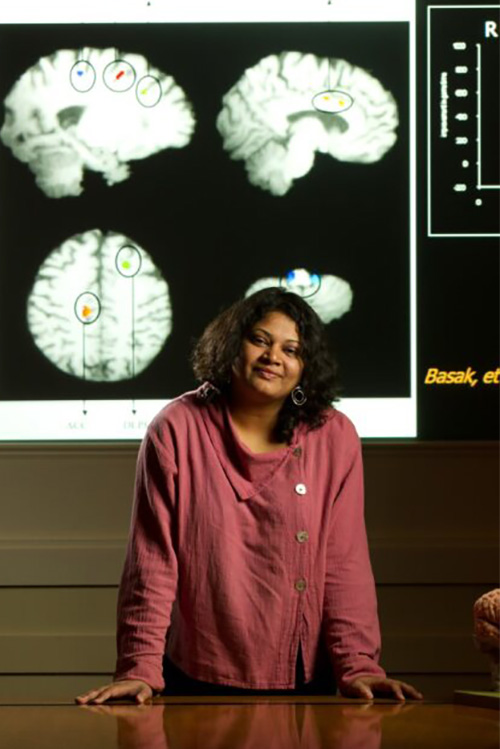Study Explores How Cardio Fitness and Exercise Combat Cognitive Decline
New research from The University of Texas at Dallas’ Center for Vital Longevity (CVL) supports the idea that the brains of older adults who maintain physical fitness by engaging in regular strenuous exercise more closely resemble those of younger adults.
Dr. Chandramallika Basak, associate professor of psychology in the School of Behavioral and Brain Sciences, is the corresponding author of a study published online April 27 and in the June print edition of Neuroscience that describes how strenuous physical activity and cardiorespiratory fitness help the brains of older adults compensate for age-related changes by improving their ability to perform complex cognitive tasks.

The results demonstrate the importance of maintaining physical fitness and regular strenuous exercise to prolong neurological health.
“Age is just one marker for cognitive health, and fitness can be a significant modifying factor,” said Basak, who directs the Lifespan Neuroscience and Cognition Lab in the CVL. “The brain activation patterns of high-fit older adults in our study resemble those of the young adults during a complex cognitive task that requires switching attention focus and updating memory rapidly. This suggests that physical fitness can significantly modify age-related changes in the brain.”
The researchers used functional MRI to measure fluctuations in blood oxygen level-dependent signals as the 52 study participants performed tasks involving several varieties of cognitive control. Limited research exists on contributions of physical activity and cardiorespiratory fitness to cognitive functions like those tested in the study, including switching, updating and event anticipation, Basak said.
“Our findings suggest that a lifestyle involving moderate to strenuous physical activity may help maintain cognitive processing in the prefrontal cortex of older adults that matches that of younger adults, while cardiorespiratory fitness may preserve neurovascular health of posterior brain regions,” Basak said. “What we mean by strenuous physical activity is a level of physical activity that actually gets your heart rate up and increases your lung capacity.”
The study not only compared high-fit and low-fit older adults — median age 73 — who were matched on many aspects, including blood pressure and general cognition, but also included younger participants with an average age of 26.
“Our findings suggest that a lifestyle involving moderate to strenuous physical activity may help maintain cognitive processing in the prefrontal cortex of older adults that matches that of younger adults.”
Dr. Chandramallika Basak, associate professor of psychology in the School of Behavioral and Brain Sciences
“If you don’t have younger adults in your sample, you don’t know whether physical fitness is helping the brain activation patterns of high-fit older adults resemble that of younger adults, or whether these activations are engagement of additional brain regions that help compensate for the detrimental effects of brain aging,” Basak said.
The older participants were separated into high-fit or low-fit categories based on their self-reported frequency of engaging in strenuous physical activities such as jogging, swimming, cycling, singles tennis, aerobic dancing or skiing.
All participants performed complex cognitive control tasks that involved remembering two sets of numbers presented against two different colored backgrounds. Participants had to decide if the number shown was the same or different from the number they had previously seen on that color. The tasks increased in difficulty depending on whether the background colors were predictable or random, whether the numbers needed to be updated in memory or not, and whether the attention focus needed to be switched or stayed on the same information.
The fMRI scans indicated that young adults primarily used the dorsolateral prefrontal cortex — a classical working memory, cognitive control center of the brain that is activated more as tasks became more demanding.
In general, the brain calls upon its resources like firefighters respond to a multi-alarm fire: If the task becomes more difficult than a single region can tackle, another station responds.
“Younger brains are more efficient. They don’t need to work hard,” Basak said. “They only need to use these extra resources when things get more difficult.”
Older brains overactivate the dorsolateral prefrontal cortex even when the task is simple.
“When a task is extremely difficult, this region’s activation typically drops in older adults whereas younger adults may still show an increase. This pattern, also known as the CRUNCH model, is a neural marker indicating that the older participants are not able to modulate this brain region anymore to support their task performance,” Basak said.
The study’s results show, however, that the CRUNCH (Compensation-Related Utilization of Neural Circuits Hypothesis) model doesn’t apply to all aging adults.
“What we found is that these high-fit older adults overactivated the dorsolateral prefrontal cortex only at moderate levels of task difficulty, whereas low-fit older participants used this region even for the simplest version of the task,” Basak said. “Moreover, high-fit older adults compensated by activating another brain region, the superior parietal lobe.
“We found such protective effects in those subjects who regularly engaged in strenuous activity and exhibited high cardiorespiratory fitness, which compensates for the decline of cognition we normally see with age,” Basak continued. “Our results suggest that the CRUNCH model needs to be modified to take into account the protective effect of physical fitness on the aging brain.”
The differences in both task performance and brain activity between young subjects and high-fit older ones were much smaller than the gaps between high-fit and low-fit older adults.
“A lot of things get worse as we get older, and some of them can have an independent impact over and beyond just aging,” Basak said. “We showed that high levels of physical activity and high cardiorespiratory fitness allow you to recruit additional brain regions that help you compensate and maintain accuracy levels. So it seems that there are independent effects of fitness that may allow us to counteract some effects of aging.”
Other authors of the paper are Shuo Qin PhD’19, now a postdoctoral research fellow at the National University of Singapore, and cognition and neuroscience doctoral student Paulina Skolasinska MS’21.

